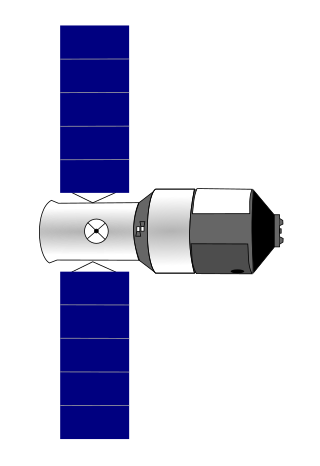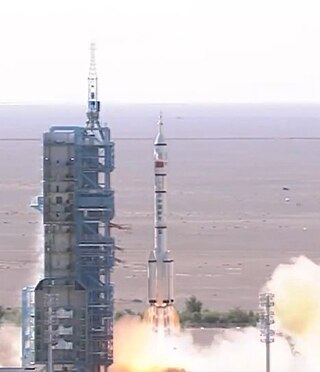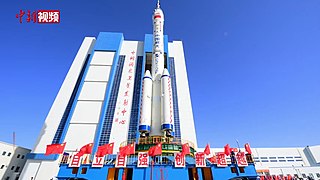
A space station is a spacecraft which remains in orbit and hosts humans for extended periods of time. It therefore is an artificial satellite featuring habitation facilities. The purpose of maintaining a space station varies depending on the program. Most often space stations have been research stations, but they have also served military or commercial uses, such as hosting space tourists.

The Tiangong program is China's space program to create a modular space station, comparable to Mir. This program is independent and unconnected to any other international space-active countries. The program is part of the China Manned Space Program that began in 1992. The core module of the Tiangong space station, the Tianhe was finally launched on 29 April 2021 marking the start of the Tiangong Space program deployment.

Tiangong, officially the Tiangong space station, is a permanently crewed space station constructed by China and operated by China Manned Space Agency. Tiangong is a modular design, with modules docked together while in low Earth orbit, between 340 and 450 km above the surface. It is China's first long-term space station, part of the Tiangong program and the core of the "Third Step" of the China Manned Space Program; it has a pressurised volume of 340 m3, slightly over one third the size of the International Space Station. The space station aims to provide opportunities for space-based experiments and a platform for building capacity for scientific and technological innovation.

Shenzhou 8 was an uncrewed flight of China's Shenzhou program, launched on 31 October 2011 UTC, or 1 November 2011 in China, by a Long March 2F rocket which lifted off from the Jiuquan Satellite Launch Center.

Shenzhou 9 was the fourth crewed spacecraft flight of China's Shenzhou program, launched at 18:37:24 CST, 16 June 2012. Shenzhou 9 was the second spacecraft and first crewed mission and expedition to dock with the Tiangong-1 space station, which took place on 18 June. The Shenzhou 9 spacecraft landed at 10:01:16 CST on 29 June in the Inner Mongolia Autonomous Region. The mission's crew included the first Chinese female astronaut, Liu Yang. The next mission was Shenzhou 10, which launched on 11 June 2013.

Shenzhou 10 was a crewed spaceflight of China's Shenzhou program that was launched on 11 June 2013. It was China's fifth crewed space mission. The mission had a crew of three astronauts: Nie Haisheng, who was mission commander and previously flew on Shenzhou 6; Zhang Xiaoguang, a former PLAAF squadron commander who conducted the rendezvous and docking; and Wang Yaping, the second Chinese female astronaut. The Shenzhou spacecraft docked with the Tiangong-1 trial space laboratory module on 13 June, and the astronauts performed physical, technological, and scientific experiments while on board. Shenzhou 10 was the 2nd and final expedition and mission to Tiangong-1 in this portion of the Tiangong program. On 26 June 2013, after a series of successful docking tests, Shenzhou 10 returned to Earth.

The China Manned Space Program, also known as Project 921 is a space program developed by the People's Republic of China and run by the China Manned Space Agency (CMSA) under the Equipment Development Department of the Central Military Commission, designed to develop and enhance human spaceflight capabilities for China. It was approved on 21 September 1992 and has been in operation ever since. The CMS commander and director are currently Xu Xueqiang and Zhou Jianping respectively; the latter has held this position since 2006, after taking over from Wang Yongzhi, who served as the first director from 1992 to 2006.

Tiangong-1 was China's first prototype space station. It orbited Earth from September 2011 to April 2018, serving as both a crewed laboratory and an experimental testbed to demonstrate orbital rendezvous and docking capabilities during its two years of active operational life.

Tiangong-2 was a Chinese space laboratory and part of the Project 921-2 space station program. Tiangong-2 was launched on 15 September 2016. It was deorbited as planned on 19 July 2019.

Tiangong-3 was a proposed Chinese space station, part of the Tiangong program. The China National Space Agency (CNSA) was originally expected to launch Tiangong-3 around 2015, following the launch of the Tiangong-2 test laboratory, originally planned for 2013. The goals for the Tiangong-2 and Tiangong-3 laboratories were merged, and the latter was therefore not ordered. The first module of the third station of the Tiangong program, Tiangong space station, was eventually launched in 2021.

Nanjing Iron and Steel Co., Ltd. is a publicly traded steel maker based in Nanjing, Jiangsu Province, China. The parent company of NISCO is Nanjing Nangang Iron and Steel United Co., Ltd., a joint venture of Hong Kong listed company Fosun International and Chinese state-owned enterprise Nanjing Iron and Steel Group in a 60–40 ratio.

The Chinese Docking Mechanism is a spacecraft docking mechanism based on the Androgynous Peripheral Attach System (APAS). There have been contradicting reports by the Chinese on its compatibility with APAS. It is used by Shenzhou spacecraft, beginning with an uncrewed Shenzhou 8, to dock to Tiangong-1. Subsequent crewed missions docked with the Tiangong-1, Tiangong-2 and the Tiangong space station. Similar docking mechanism was also introduced to the Tianzhou cargo spacecraft. Tianzhou 1 was the first cargo spacecraft which docked with the Tiangong-2. It has a circular transfer passage that has a diameter of 800 mm (31 in). The androgynous variant has a mass of 310 kg and the non-androgynous variant has a mass of 200 kg.

Shenzhou 11 was a crewed spaceflight of the Shenzhou program of China, launched on 17 October 2016 from the Jiuquan Satellite Launch Center. It was China's sixth crewed space mission, at 33 days, it was the longest until the follow-up Shenzhou 12 mission which lasted 3 months. Two days after launch, it docked with the Tiangong-2 space laboratory, which had been launched on 15 September 2016. Shenzhou 11 was the first and only expedition and mission to Tiangong-2 in this portion of the Tiangong program.

Tianzhou 1 was the debut mission of the Tianzhou-class uncrewed cargo spacecraft. It was developed as part of the crewed space program of China. Tianzhou means "heavenly vessel" in Chinese. On 20 April 2017, Tianzhou 1 was launched by rocket Long March 7 at China Wenchang Spacecraft Launch Site. It successfully docked with the Tiangong-2 space laboratory on 22 April 2017 at 12:16 (UTC+8). Tianzhou 1 was deorbited on 22 September 2017. It plunged into Earth's atmosphere and burned up after a set of braking maneuvers under ground control.

Shenzhou 12 was a Chinese spaceflight to the Tiangong space station, launched on 17 June 2021. It carried three People's Liberation Army Astronaut Corps (PLAAC) taikonauts on board a Shenzhou spacecraft. The mission was the seventh crewed Chinese spaceflight and the twelfth flight overall of the Shenzhou program. It was the first flight to Tiangong, and the first Chinese crewed spaceflight since Shenzhou 11 in 2016.

Tianzhou 4 was the fourth mission of the Tianzhou-class uncrewed cargo spacecraft, and the third resupply mission to Tiangong Space Station carrying 5 tons of cargos and 1 ton of propellant. It is the largest load capacity cargo spacecraft that is on active duty. It launched on 9 May 2022, docking successfully with the Tiangong space station at the aft port 6 hours after launch. Like previous Tianzhou missions, the spacecraft launched from the Wenchang Satellite Launch Center in Hainan, China on a Long March 7 rocket.

Shenzhou 14 was a Chinese spaceflight to the Tiangong space station, launched on 5 June 2022. It carried three People's Liberation Army Astronaut Corps (PLAAC) taikonauts on board a Shenzhou spacecraft. The mission was the ninth crewed Chinese spaceflight and the fourteenth flight overall of the Shenzhou program.














